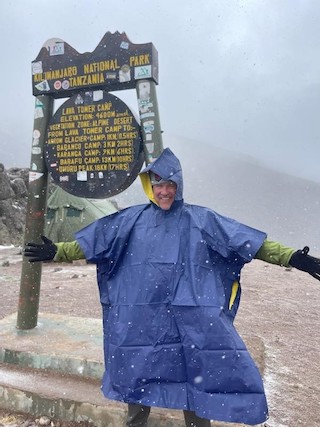“You Don’t Need Two Kidneys To Climb Mount Kilimanjaro”
To show how living organ donors can still achieve great physical feats, Steve Wilson scaled the tallest mountain in Africa — and has more adventures on the horizon.
On March 10, 2022, Steve Wilson stood more than 19,000 feet above sea level, overlooking the rocky plains of Tanzania. He and 19 others — all of whom were fellow kidney donors — had reached the summit of Mount Kilimanjaro, achieving their goal of making it to the top of the tallest free-standing mountain in the world to raise awareness for living kidney donation.
“We wanted to prove to people that you don’t need two kidneys to climb Mount Kilimanjaro,” says Wilson, who climbed with friends from an awareness group called Kidney Donor Athletes. “It was a very emotional moment, and one that I’ll never forget.”

Dr. Joseph Del Pizzo
Wilson was inspired to become a living organ donor in the summer of 2019 after seeing a post from a high school friend, whose daughter had just received a kidney. “It got me thinking, there’s just no cooler thing to do than to give of yourself like that to another person to save their life,” he says. “I started doing a little research and it confirmed that you can live a perfectly normal life with one kidney. I then made the call to the hospital.”
Wilson reached out to Dr. Joseph Del Pizzo, a urologist and living donor surgeon at NewYork-Presbyterian/Weill Cornell Medical Center, to discuss the process of donating a kidney. And in February 2020, he underwent the minimally invasive surgery at NewYork-Presbyterian/Weill Cornell Medical Center.
The Benefits of Organ Donation
There are more than 100,000 candidates in the nation waiting for an organ transplant, according to the Organ Procurement and Transplantation Network. Wilson became what is called a nondirected living donor, which means that he wasn’t giving his kidney to a specific person he knew. Rather, the recipient would be a stranger based on a medical match.
On February 1, 2020, Wilson was told of a potential recipient, and five days later he underwent surgery at NewYork-Presbyterian/Weill Cornell Medical Center.
“There was a small slice on either side of my belly button,” says Wilson, who has never met the recipient of his kidney. “There are no big scars, no big cuts. It was not particularly painful. I was walking around a few hours after surgery, and I was walking around the mall two days after surgery. Two weeks to the day, I was back on my indoor bike trainer with no repercussions whatsoever.”
“A lot of people are under the misconception that you can only donate once you’ve passed away,” says Dr. Del Pizzo. The truth is that being a living kidney donor presents a very low long-term health risk, he says. “[Otherwise], we wouldn’t let Steve or anyone else donate a kidney.”
Reaching the Top
After his organ donation, Wilson joined Kidney Donor Athletes, which has members across the world. Throughout the COVID-19 pandemic, group members saw each other frequently on Zoom, and one day they talked about what they could do collectively to raise awareness.
“Somebody said something about Kilimanjaro,” Wilson recalls. “We said, ‘Wow, first of all, that would be a lot of fun.’ But mostly we could raise awareness for living kidney donation and spread that message that having just one kidney doesn’t change your life. You can still do the same things you did before you gave a kidney.”

It took Steve and the Kidney Donor Athletes team seven days to summit Mount Kilimanjaro.
After many months of planning and training, the group left base camp on March 4, 2022. Braving ferocious winds and cold temperatures, they reached the top six days later, on World Kidney Day.
For Wilson, the adventure continues — in October, he will travel to Hawaii to participate in the Ironman World Championship and continue to demonstrate that people can live their most active life after organ donation.
“Whether it was climbing Kilimanjaro, running a marathon, or going for a bike ride — your level of activity prior to donating is not going to change after you donate,” says Wilson.
But the best part, Wilson shares, is knowing that he made a lasting difference with a single selfless act. “To help somebody live to see their children grow up, their grandchildren grow up, or to just give somebody a second chance at life — it’s a wonderful feeling,” he says. “I’ve never met a living organ donor that regrets their decision.”
And Wilson’s act will continue to have a ripple effect. “Steve didn’t just help the person who got his kidney. Steve also helped 100,000 people who are on the list, because when Steve’s recipient came off the list, that moved everybody up on the list,” says Dr. Del Pizzo. “The living donors help more than just the person they are directly helping. They indirectly help tens of thousands, and they’re the real heroes.”
To learn more about becoming a living organ donor, visit nyp.org/organdonor.

